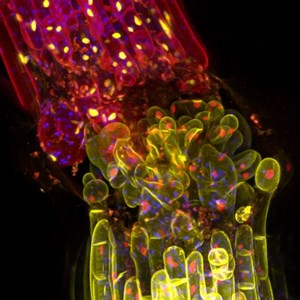Contact
 Charles Melnyk, Assistant Professor
Charles Melnyk, Assistant Professor
Group leader at the Melnyk lab
Department of Plant Biology, SLU
Telephone: (+46) 18673238
E-mail: charles.melnyk@slu.se

We specialise in how plant development responds to abiotic and biotic stresses.
Our lab is particularly interested in understanding how plants graft. For millennia, people have cut and joined together different plant species and cultivars to improve yields, improve disease resistance, improve stress resistance and for propagation.
Today, grafting is widely used in vineyards, orchards, vegetable nurseries and in horticulture. Despite the economic importance of grafting, we have little idea how plants can fuse tissues and connect the vascular tissues between different species or cultivars.
A better understanding of plant grafting will improve grafting so that more species can be grafted, and also provide us with a fundamental understanding of how plants heal wounds and distinguish self from non-self.
Our lab has also recently started working with parasitic plants, devastating pathogens that attach to host plants to withdraw nutrients and reduce yields. Interestingly, parasitic plants can also form vascular connections to their hosts, which are often completely unrelated plants. Thus, there is something unique about how parasitic plants can overcome recognition barriers. We are studying parasitic plants to get a better idea how they fuse tissues and form vascular connections to unrelated plants.
Read more about our research, staff, publications, news and vacancies here.
 Charles Melnyk, Assistant Professor
Charles Melnyk, Assistant ProfessorGroup leader at the Melnyk lab
Department of Plant Biology, SLU
Telephone: (+46) 18673238
E-mail: charles.melnyk@slu.se